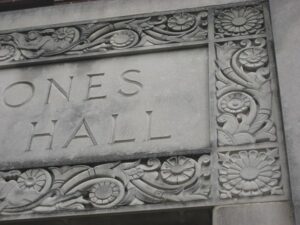Yesterday, I wrote about the excess capacity at Michigan’s public universities. Based on each university’s peak enrollment, I calculated that Michigan currently has more than 60,000 unfilled slots in its public universities. But that pales in comparison to the enormous enrollment losses at the state’s community colleges.
Exactly how much space are we talking about? Something in the 185,500-seat neighborhood. Right now, Michigan’s community colleges are operating at about 55% capacity. That estimate comes from calculating the difference between peak enrollment at each Michigan community college and its 2021 enrollment as reported to the National Center for Education Statistics. The shrinkage means that Michigan’s seven largest community colleges – if operated at their peak enrollments – could serve all current Michigan community college students.
Enrollment losses at that level mean lost tuition revenues of more than $300M for the colleges. Among workers, it represents an annual loss in income of more than $140M, based on the difference in annual earnings between high school and community college graduates in Michigan. That’s a lot for everyone to leave on the table each year. Worse, it means that Michigan is less likely to attract new employers, and more likely to lose existing ones based on the educational attainment of its workforce.
Enrollment losses by the numbers
So, what do the enrollment losses at Michigan’s community colleges look like? The table below shows each institution’s peak unduplicated head count and year, the 2021 unduplicated headcount, the difference between peak headcount and current headcount, and the percent capacity at which the institution is operating.
| Institution | Peak | Peak Year | Current | Change | % Capacity |
|---|---|---|---|---|---|
| Gogebic Community College | 1568 | 2011 | 1375 | -193 | 88% |
| Alpena Community College | 2791 | 2010 | 2335 | -456 | 84% |
| Washtenaw Community College | 23206 | 2010 | 18734 | -4,472 | 81% |
| Bay De Noc Community College | 3215 | 2011 | 2429 | -786 | 76% |
| Grand Rapids Community College | 25605 | 2011 | 18142 | -7,463 | 71% |
| Muskegon Community College | 7503 | 2013 | 5128 | -2,375 | 68% |
| West Shore Community College | 2210 | 2010 | 1509 | -701 | 68% |
| Saint Clair County Community College | 6944 | 2011 | 4596 | -2,348 | 66% |
| Lake Michigan College | 6927 | 2011 | 4377 | -2,550 | 63% |
| Henry Ford College | 26724 | 2011 | 16811 | -9,913 | 63% |
| Northwestern Michigan College | 6645 | 2011 | 4152 | -2,493 | 62% |
| Kirtland Community College | 3193 | 2007 | 1982 | -1,211 | 62% |
| Schoolcraft College | 22809 | 2013 | 13994 | -8,815 | 61% |
| Delta College | 17115 | 2010 | 9738 | -7,377 | 57% |
| Kalamazoo Valley Community College | 18322 | 2010 | 10128 | -8,194 | 55% |
| Glen Oaks Community College | 2833 | 2009 | 1506 | -1,327 | 53% |
| Mid Michigan College | 7585 | 2011 | 3983 | -3,602 | 53% |
| North Central Michigan College | 4510 | 2010 | 2347 | -2,163 | 52% |
| Macomb Community College | 47490 | 2007 | 24180 | -23,310 | 51% |
| Oakland Community College | 46592 | 2009 | 23708 | -22,884 | 51% |
| Monroe County Community College | 6508 | 2010 | 3259 | -3,249 | 50% |
| Jackson College | 11130 | 2010 | 5559 | -5,571 | 50% |
| Southwestern Michigan College | 4402 | 2011 | 2185 | -2,217 | 50% |
| Montcalm Community College | 3840 | 2008 | 1868 | -1,972 | 49% |
| Wayne County Community College District | 34698 | 2011 | 15130 | -19,568 | 44% |
| Lansing Community College | 34067 | 2007 | 14739 | -19,328 | 43% |
| Mott Community College | 19113 | 2008 | 7479 | -11,634 | 39% |
| Kellogg Community College | 14648 | 2010 | 5335 | -9,313 | 36% |
| Total | 412193 | 226708 | -185,485 | 55% |
Michigan’s community college system is dying
There’s a lot to consider here, but community colleges have a lot of work to do if they intend to recover in any meaningful way. That work must start with establishing new programs that enable workers to earn living wages. It also means that community colleges must eliminate programs that do not provide a direct pathway to the middle class. When two years of classroom learning increases a person’s annual salary by only a few thousand dollars over what that person can make having only a high school diploma, the juice ain’t worth the squeeze.
Second, the Trustees must ensure that the revenues at each institution fund its core mission and provide adequate care for the campus infrastructure. That likely means tying the size of the administration tightly to the institution’s enrollment. When enrollment declines, the administration cannot grow. Nor can revenues be diverted to non-academic priorities. Regardless of the rationale for this kind of spending, the primary mission of the community college is education. Everything else is a distraction that the Board of Trustees must not accommodate.
This should be a wake-up call to Michigan residents, the community college system is dying. The community colleges’ current condition results from a chronic lack of investment in the colleges, their academic programs, their teaching staffs, and their campus infrastructures. Diversion of funds from instruction to administration, instruction to construction, and infrastructure to pet projects have taken their toll. The result of this lack of focus on the strategic mission is that there is little to distinguish an associate degree from a high school diploma. Community colleges have no competitive advantage over high schools, and they also cannot compete with four-year universities.
That’s a dangerous position to be in.
Photo Credit: Pixel, via Flickr






























